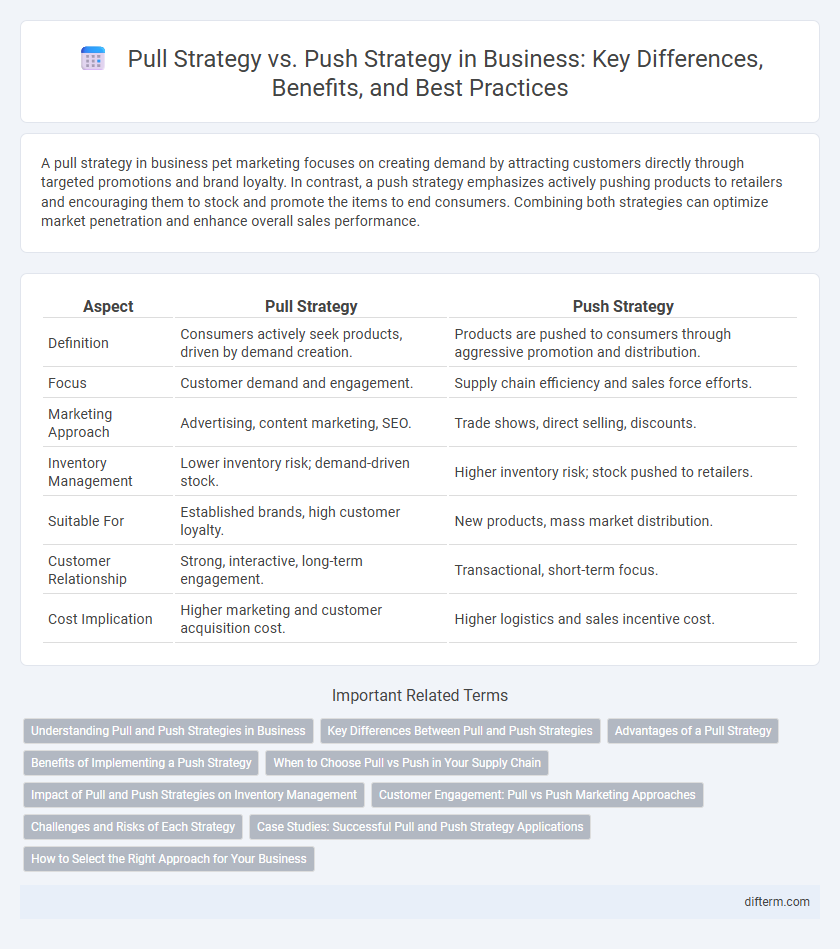A pull strategy in business pet marketing focuses on creating demand by attracting customers directly through targeted promotions and brand loyalty. In contrast, a push strategy emphasizes actively pushing products to retailers and encouraging them to stock and promote the items to end consumers. Combining both strategies can optimize market penetration and enhance overall sales performance.
Table of Comparison
| Aspect | Pull Strategy | Push Strategy |
|---|---|---|
| Definition | Consumers actively seek products, driven by demand creation. | Products are pushed to consumers through aggressive promotion and distribution. |
| Focus | Customer demand and engagement. | Supply chain efficiency and sales force efforts. |
| Marketing Approach | Advertising, content marketing, SEO. | Trade shows, direct selling, discounts. |
| Inventory Management | Lower inventory risk; demand-driven stock. | Higher inventory risk; stock pushed to retailers. |
| Suitable For | Established brands, high customer loyalty. | New products, mass market distribution. |
| Customer Relationship | Strong, interactive, long-term engagement. | Transactional, short-term focus. |
| Cost Implication | Higher marketing and customer acquisition cost. | Higher logistics and sales incentive cost. |
Understanding Pull and Push Strategies in Business
Pull strategy in business focuses on creating consumer demand to pull products through the distribution channel, often through targeted marketing and promotions. Push strategy involves actively pushing products to retailers and customers by using tactics like trade shows, direct selling, and sales incentives to increase product availability. Businesses balance pull and push strategies to optimize market reach and drive sales by aligning production, distribution, and promotional efforts.
Key Differences Between Pull and Push Strategies
Pull strategy relies on creating consumer demand to attract customers toward the product, leveraging techniques like content marketing and social media engagement. Push strategy focuses on actively promoting products to retailers or distributors through direct sales and trade promotions to ensure product availability. The key differences include demand generation versus supply chain emphasis, customer-driven versus sales-driven approaches, and long-term brand building versus short-term sales goals.
Advantages of a Pull Strategy
A pull strategy leverages strong customer demand to drive product sales, reducing excess inventory and minimizing storage costs. It enhances brand loyalty by engaging customers through tailored marketing efforts and personalized experiences. This approach fosters long-term customer relationships and improves market responsiveness by aligning supply closely with consumer needs.
Benefits of Implementing a Push Strategy
Implementing a push strategy streamlines inventory management by forecasting demand and ensuring products are available when needed, reducing stockouts and overstock situations. This approach also fosters stronger relationships with intermediaries by encouraging proactive promotions and distribution efforts. Enhanced control over the supply chain enables consistent brand messaging and faster product launches, increasing market penetration and sales efficiency.
When to Choose Pull vs Push in Your Supply Chain
Pull strategy is ideal when demand is unpredictable or highly variable, allowing companies to produce and deliver products based on actual customer orders, minimizing inventory costs and reducing waste. Push strategy suits businesses with stable demand forecasts, enabling mass production and bulk distribution to optimize manufacturing efficiency and economies of scale. Choosing between pull vs push in your supply chain depends on factors like product type, market demand stability, lead times, and inventory holding costs to balance responsiveness and operational efficiency.
Impact of Pull and Push Strategies on Inventory Management
Pull strategies in inventory management reduce excess stock by aligning production directly with customer demand, minimizing holding costs and avoiding overproduction. Push strategies often lead to higher inventory levels as products are manufactured based on forecasts, increasing the risk of obsolescence or stockouts if demand forecasts are inaccurate. Efficient inventory turnover and reduced waste are typically achieved when pull strategies are integrated with just-in-time (JIT) systems, while push strategies may require sophisticated demand planning to optimize stock levels.
Customer Engagement: Pull vs Push Marketing Approaches
Pull marketing strategies prioritize customer engagement by attracting consumers through valuable content, personalized experiences, and brand loyalty initiatives, fostering long-term relationships and organic growth. Push marketing relies on direct promotion and proactive outreach, using tactics such as advertising, sales promotions, and cold calls to immediately drive sales but often results in lower customer retention. Effective business growth combines pull's focus on meaningful engagement with push's ability to increase short-term visibility and conversion rates.
Challenges and Risks of Each Strategy
Pull strategy faces challenges like high dependence on customer demand fluctuations and significant marketing investment to attract consumers, risking inconsistent sales and increased costs. Push strategy risks inventory surplus and waste due to overproduction while relying heavily on strong relationships with distribution channels, potentially leading to channel conflicts and reduced flexibility. Both strategies require careful demand forecasting and market analysis to mitigate financial losses and operational inefficiencies.
Case Studies: Successful Pull and Push Strategy Applications
Case studies highlight Coca-Cola's successful pull strategy by creating consumer demand through extensive advertising and brand loyalty programs, driving retailers to stock their products. In contrast, Procter & Gamble's push strategy leverages aggressive trade promotions and retailer incentives to ensure product placement and visibility in stores. These examples demonstrate how aligning marketing tactics with distribution channels can effectively boost sales and market presence.
How to Select the Right Approach for Your Business
Selecting the right approach between pull strategy and push strategy depends on your business goals, target audience behavior, and product type. A pull strategy works best for businesses aiming to build long-term customer loyalty through demand generation and brand engagement, while a push strategy suits companies focusing on immediate sales by actively promoting products to retailers or customers. Analyze market demand, customer purchasing patterns, and supply chain capabilities to determine the most effective strategy tailored to your business needs.
pull strategy vs push strategy Infographic

 difterm.com
difterm.com